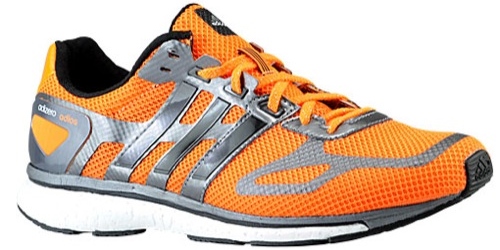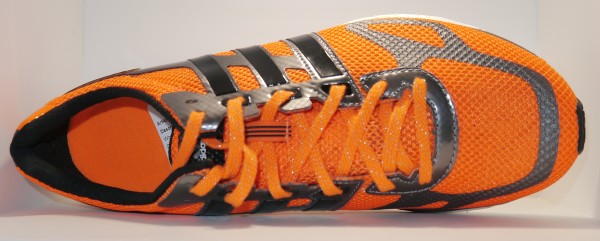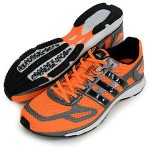Rarely do I find a running shoe that can be used for such a wide variety of workouts from long runs to track repetitions.
But sometimes, a shoe just has it all. Meet the Adidas Adios Boost, a lightweight trainer that works for both fast workouts and marathons.

I first tested the shoe during my build-up for the 2014 Boston Marathon after a recommendation from one of my runners. At first, I didn’t love it. I wasn’t used to the midsole material and the lacing system is a bit cumbersome.
But it grew on me and after a few weeks I loved every run in the Boost.
Soon I committed to racing Boston in them and even though my race didn’t go exactly to plan, the shoes worked out incredibly well. My calves tend to cramp during challenging long runs if I’m in a shoe that’s too minimalist, but the Adios Boost provided a nice compromise between low-drop flats without enough cushion and more cushioned trainers that aren’t responsive enough for racing. For examples of these types of shoes, see all of my running shoe reviews.
Even though the hefty $140 price tag is a big barrier for a lot of runners, they’re a versatile training shoe that delivers a lot of value despite the cost.
While you can read shoe reviews on many other sites, I occasionally review select running shoes because I want you to have the perspective of a coach. You’ll learn how they can be used in training, for what races or workouts, and if they could potentially prevent injuries when used correctly.
This type of review perspective isn’t as common so I hope it’s helpful for you.
Adidas Adios Boost First Impressions
Out of the box, my neon orange pair of Boosts hurt my eyes. But in a good way because I like abrasively colored shoes that stand out in a crowd
Here are some quick specs:
- Weight: 8.1 ounces (men, size 8)
- Heel-toe drop: 10.4 mm (27.5 mm heel and 17.1 mm forefoot)
- Midsole material: “Boost” technology (beads fused together)
What’s most interesting about the Adios Boost – and what has been so heavily marketed over the last few months – is the midsole material. Allegedly, the new technology delivers more energy return than traditional EVA foam. In other words, it’s bouncier and will improve your efficiency, or running economy.
Does this mean you’ll run faster?
Does this mean you’ll have more spring in your step during the final miles of a marathon?
Will these shoes save your legs from the crushing fatigue and soreness of 26.2 miles?
Well, if my Boston performance is any indication, then no. But I am a case study of one and it may be true to a certain extent. However, I’m not aware of any studies that support Adidas’ claims regarding it’s ability to “boost” running economy (see what I did there?).
But the sole is significantly softer than most of the foam Adidas uses in its running shoes (like the Adizero Boston). I like the combination of a more firm sole with a relatively soft running surface like trails, but I still loved the ride of the Boost. It didn’t feel too squishy, even on softer surfaces. And during workouts, the ride felt responsive when I was running well under 6:00 mile pace.
Aside from the midsole material, there were two characteristics of the Adidas Adios Boost that struck me during my time training with them. First, the toe box seemed unusually wide for a shoe that many consider a racing flat. Most racing flats are narrow and snug while the Boost provides a roomy forefoot area that gave me no blisters or black toenails during my marathon training. I also wore them for the Rock ‘n’ Roll DC Half Marathon and they felt great.
Second, the lacing system was obnoxious to use at first. It reminded me of the structure of the laces of the ASICS Blur 33, with plastic pieces along the tongue. It made tying the laces tight enough difficult, but once the Boosts were broken in it wasn’t a problem.

You can see in the picture above how the laces are woven through pieces of plastic. For me personally, I don’t like this as much as more traditional lacing systems.
Why I’ll Keep Paying $140 for the Adios Boost
$140 for a pair of shoes? The humanity!
But still, these shoes are fantastic. I’m on my second pair and even after 300 miles on the first, they were still going strong. The only reason I bought another pair was because I wanted a “fresher” pair for Boston.
The combination of a responsive but cushioned sole with a more traditional heel-toe drop and a lighter weight is what makes the the Adidas Adios Boost so versatile. It combines aspects of more traditional running shoes with racing flats so that it’s perfect for longer races like the marathon and half marathon.
So even with the exorbitant price tag, why on Earth would I keep paying that for a pair of running shoes? Easy:
- At 8.1 ounces, they’re light but not too light. They’re in my personal ideal weight zone.
- Even though the heel-toe drop is a bit high for a racing shoe, they’re responsive and “feel” fast (unlike the Hoka’s)
- They’re versatile and can be worn for a wide variety of workouts and race distances
- They feel good on my feet
It’s worth noting that point #4 is the most important here. After fielding countless emails about shoes and what options are best for certain runners, I have to say that fit is truly what matters.
On my shoe review page, I explain that I don’t recommend running shoes. Here’s an excerpt:
Every runner is an individual with a different stride pattern, gait, weight, use profile, injury history, and biomechanical flaws. What works for me may be a terrible choice for you.
The best way to find what works for you is to test as many shoes as you can. You may find that a certain type works best on easy runs while you tolerate a very different style for faster workouts.
Always read any running shoe review with a grain of salt and a critical eye. Remember that I’m less than 130 pounds and a relatively efficient runner. While I used to be injury-prone I’ve only had a single injury in five years. These factors allow me to run in many types of running shoes without too many problems.
As someone who loves running shoes and owns more than ten pairs of them at any one time, it’s obvious that I know what I like. I’m very particular so when I find something that works, I stick with it. That’s why I’ve owned about 25 pairs of the Asics Speedstar!
So will you love the Adios Boosts? I can’t say. But there’s only one way to find out – give them a try!